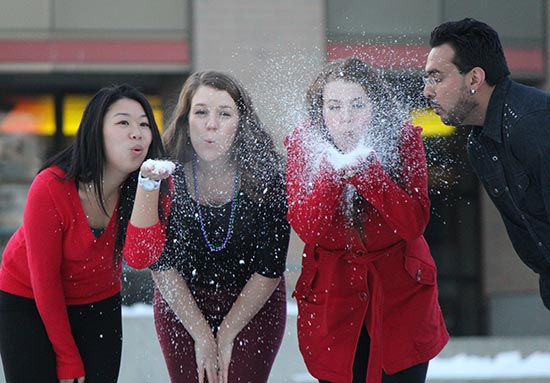
Stay warm, dry, and safe outdoors whether on foot or on the road with these safety tips from TRU’s Health and Safety Officer.
By Gordon Maurits
Winter has arrived in a fury and can pose serious risks for slipping and tripping as well as cold stress and frostbite. It is very important to take the proper measures to protect yourself from the elements. We have had several slip and falls already and I encourage you to ensure you wear proper footwear for the season.
Safe weather for outdoor acitivity
You should stay indoors if the temperature or the wind chill falls below -25 C (-13 F). This is the temperature at which exposed skin freezes in a few minutes.
Clothing for outdoors
All winter activities require warm, dry clothing. To prevent frostbite, you should be dressed in warm clothes, including a hat and clothing made of tightly woven fibres, such as wool, which trap warm air against your body. A few loose, lighter layers protect better than one heavy garment (an absorbent synthetic fabric next to skin, a warmer middle layer, and a water resistant/repellent outer layer).
Vulnerable areas such as fingers, toes, ears and nose, should be protected. A single pair of socks, either wool or a wool blend (with silk or polypropylene) is better than cotton which offers no insulation when wet. Avoid extra thick socks as they can cause cold feet by restricting blood flow and air circulation around the toes. Be sure boots are dry and not too tight.
Preventing slips and falls
At this time of year, wind, rain and snow all play a part in the increased frequency of slips, trips and falls. As we enter the cold, wet winter months, it is more critical than ever to take steps to avoid these types of injuries.
Statistics show that almost 80 percent of slips and falls are due to snow and ice in the parking lots and on sidewalks, with more than 50 percent occurring between 6 am and noon. Take special caution while in the parking lots in the morning. When possible, avoid north-facing entrances to buildings, which tend to remain icy and slippery.
Appropriate footwear in inclement weather can’t be overemphasized. If you prefer to wear slick-soled or high-heeled shoes, you may want to bring along an extra pair of shoes for crossing the parking lot. If you must walk on a slippery surface, slow down, take small steps and keep a hand free for balance.
Wet surfaces are a huge risk. Mop and dry spills immediately. Place caution signs in problem areas until dry.
Be smart—take only what you can carry to maintain balance, use handrails, slow down and watch for hazards.
Winter driving
Do you know how to drive properly in winter conditions? The following tips could save you from problems when you are out on the road.
Maintain a safe following distance. It takes longer to stop on a slippery road. Look ahead and keep plenty of distance between you and other cars (at least four seconds).
Drop your speed to match road conditions. The posted speed is the maximum speed under ideal conditions. In winter, it is safer to drive below the posted speed. No matter how much experience you have, the way your car will move on snow or ice always has an element of unpredictability.
Watch for black ice. Slow down when approaching icy areas such as shaded areas, bridges and overpasses as these sections of road freeze sooner than others in cold weather. Watch for “black ice”, areas of the road with a thin, almost invisible coating of ice, which can cause your vehicle to suddenly lose control when you brake or corner.
Accelerate and brake slowly. On slick roads, start slowly and accelerate gradually to maintain traction and avoid spinning your wheels. When stopping, plan well in advance, apply the brakes gently and slowly add pressure. Never brake suddenly. Avoid unexpected quick movements that could put you in a spin. Anticipate turns, stops, and lane changes well before they occur.
Know how to handle a skid. A skid happens when your wheels slide out of control on a slippery surface and is a result of driving too fast for road conditions. If you start to skid, ease off the brake or accelerator, and look and steer smoothly in the direction you want to go. Be careful not to over-steer. If you are on ice and skidding in a straight line, step on the clutch or shift to neutral.
See and be seen. It is critical for drivers to see and be seen in low light conditions, and when blowing snow impairs visibility. Always drive with your headlights on.
Beware of plows. Be extremely cautious when approaching highway maintenance vehicles such as snow plows and salt or sand trucks. Maintain a safe following distance. These vehicles throw up snow and spray, making it difficult to see.
Gordon Maurits
Health and Safety Officer
TRU Safety and Emergency Management Department
T: 250-828-5139


